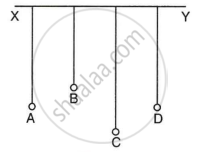Advertisements
Advertisements
प्रश्न
A vibrating tuning fork, held over an air column of a given length with its one end closed, produces a loud audible sound. Name the phenomenon responsible for it and explain the observation.
उत्तर १
The phenomenon responsible for producing a loud audible sound is named resonance. The vibrating tuning fork causes the forced vibrations in the air column. For a certain length of air column, a loud sound is heard. This happens when the frequency of the air column becomes equal to the frequency of the tuning fork.
उत्तर २
Resonance describes the phenomenon. When the tuning fork frequency is 256 Hz, the loudness of a sound can be either 256 Hz or an integer multiple of 256. i.e., (256 × 1) Hz, (256 × 2) Hz, (256 × 3) Hz, ... or (256 × 5). In other words, the frequency of the tuning fork is 256 Hz, 512 Hz, 768 Hz or 1280 Hz.
APPEARS IN
संबंधित प्रश्न
Name the phenomenon involved in tunning a radio set to a particular station
What are mechanical waves?
How does the medium affect the amplitude of free/natural vibrations of a body?
In following figure shows two tuning forks A and B of the same frequency mounted on two separate sound boxes with their open ends facing each other. The fork A is set into vibration.
- Describe your observation.
- State the principle illustrated by this experiment.

How do you tune your radio set to a particular station ? Name the phenomenon involved in doing so and define it.
In fig. shows two tuning forks P and Q of the same frequency mounted on separate sound boxes with their open ends facing each other. The fork A is set into vibration. (i) Describe your observation. (ii) State the principle illustrated by this experiment.

In Fig. A, B, C and D are four pendulums suspended from the same elastic string XY. The lengths of pendulum A and D are equal, while the length of pendulum B is shorter and of the pendulum C is longer. Pendulum A is set into vibrations.

- What is your observation about the vibrations of pendulum D?
- Give reason for your observation in part (a).
- What type of vibrations take place in pendulums Band C?
- Give reason for the answer in part (c).
What do you understand by free (or natural) vibrations?
Explain free and forced vibrations. Give an experimental arrangement to illustrate the phenomenon of resonance.
